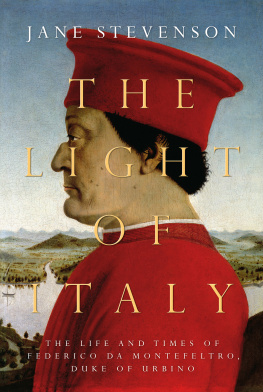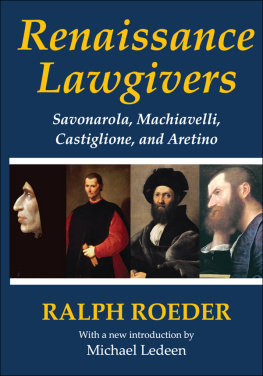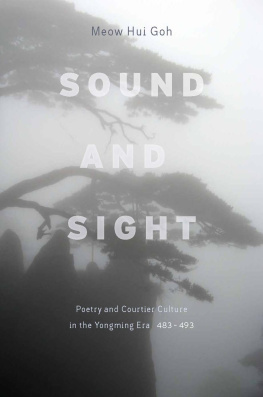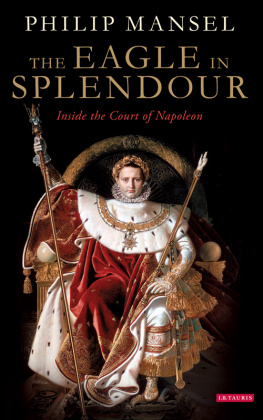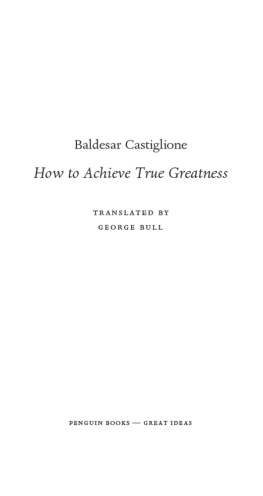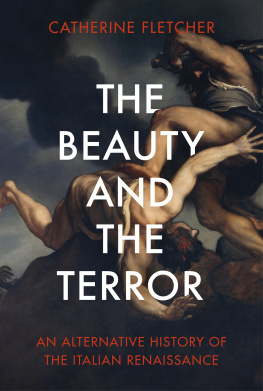THE COURTIER
Baldesar Castiglione

TRANSLATED AND WITH
AN INTRODUCTION BY
GEORGE BULL
PENGUIN BOOKS
PENGUIN BOOKS
Published by the Penguin Group
Penguin Books Ltd, 80 Strand, London WC2R 0RL, England
Penguin Putnam Inc., 375 Hudson Street, New York, New York 10014, USA
Penguin Books Australia Ltd, 250 Camberwell Road, Camberwell, Victoria 3124, Australia
Penguin Books Canada Ltd, 10 Alcorn Avenue, Toronto, Ontario, Canada M4V 3B2
Penguin Books India (P) Ltd, 11 Community Centre, Panchsheel Park, New Delhi 110 017, India
Penguin Books (NZ) Ltd, Cnr Rosedale and Airborne Roads, Albany, Auckland, New Zealand
Penguin Books (South Africa) (Pty) Ltd, 24 Sturdee Avenue, Rosebank 2196, South Africa
Penguin Books Ltd, Registered Offices: 80 Strand, London WC2R 0RL, England
www.penguin.com
This translation published 1967
Reprinted with revisions 1976
Reprinted 2003
34
Copyright George Bull, 1967
All rights reserved
Except in the United States of America, this book is sold subject to the condition that it shall not, by way of trade or otherwise, be lent, re-sold, hired out, or otherwise circulated without the publishers prior consent in any form of binding or cover other than that in which it is published and without a similar condition including this condition being imposed on the subsequent purchaser

THE BOOK OF THE COURTIER
BALDESAR CASTIGLIONE was born in 1478, a member of an ancient Italian aristocratic family. He received a thorough humanistic education, acquiring a refined appreciation of art. He was essentially a courtier, and his literary activities were spare-time occupations. In 1504, after an unhappy period in Mantuan employ, he entered the service of Guidobaldo of Montefeltro, Duke of Urbino. The ensuing years were the most satisfying of his life. He enjoyed the confidence of the Duke, who frequently entrusted him with important missions, and in his leisure moment he participated in the literary and intellectual activities of the court, then one of the most brilliant in Italy. After Guidobaldos death in 1508, he remained in the service of the new Duke, Francesco Maria della Rovere, becoming, in 1513, resident ambassador in Rome. In 1515 the expulsion of Francesco Maria from Urbino deprived him of a job, and in the years 151619 he lived quietly on his estates near Mantua. His major work is The Book of the Courtier. He also wrote a small number of excellent poems both in Latin and Italian. In 1519 he returned to Rome, as Mantuan ambassador, and after further activities on behalf of his Mantuan masters entered Papal service in 1524. From that date until his death in 1529 he was Papal Nuncio in Spain.
GEORGE BULL was an author and journalist who translated six volumes for Penguin Classics: Benvenuto Cellinis Autobiography, The Book of the Courtier by Castiglione, Vasaris Lives of the Artists (two volumes), The Prince by Machiavelli and Pietro Aretinos Selected Letters, as well as Aretinos The Stablemaster in Five Italian Renaissance Comedies. After reading History at Brasenose College, Oxford, George Bull worked for the Financial Times, McGraw-Hill World News, and for the Director magazine, of which he was Editor-in-Chief until 1984. He was appointed Director of the Anglo-Japanese Economic Institute in 1986. He was a director of Central Banking Publications and the founder and publisher of the quarterly publications Insight Japan and International Minds. His books include Vatican Politics; Bid for Power (with Anthony Vice), a history of take-over bids; Renaissance Italy, a book for children; Venice: The Most Triumphant City, Inside the Vatican; a translation from the Italian of The Pilgrim; The Travels of Pietro della Valle; and Michelangelo: A Biography (Penguin, 1996; St Martins Press, NY, 1997). George Bull was elected a Fellow of the Royal Society of Literature in 1981 and a Vice-President of the British-Italian Society in 1994. He was awarded an OBE in 1990. George Bull was made Knight Commander of the Order of St Gregory in 1999, and awarded the Order of the Sacred Treasure, Gold Rays with Neck Ribbon (Japan) in 1999. He died on 6 April 2001.
CONTENTS
FOR JULIAN AND SIMON
INTRODUCTION
BALDESAR CASTIGLIONE, courtier and diplomat, poet, scholar and soldier, is generally thought of as himself typifying the gentlemanly virtues expounded and extolled in The Book of the Courtier. The comment of the Emperor Charles V, when he heard of his death, has become famous: Yo vos digo que es muerto uno de los mejores caballeros del mundo I tell you, one of the finest gentlemen in the world is dead (a tribute, ironically, in the language in which chivalry was to receive its literary death-blow from another well-rounded man, Miguel de Cervantes, about seventy years later). The portrait of Castiglione (now in the Louvre) by Raphael of Urbino confirms the Emperors judgement. In the words of Castigliones English biographer: The noble brow and broad forehead, the fine eyes, with their clear intense blue and vivid brightness, give the impression of intellectual power and refinement, tinged with a shade of habitual melancholy. All the spiritual charm and distinction of Castigliones nature, all the truth and loyalty of his character, are reflected in this incomparable work, which is a living example of the ideal gentleman and perfect courtier.
Castiglione was sensitive, scrupulous and hard-working. It is refreshing to remember that the daunting paragon of refinement and courtesy was also indecisive, fussy, snobbish and ambitious; that his half-hearted approaches to marriage were inspired by his urgent need for money (his eventual marriage, none the less, was extremely happy); that he was not at all distinguished as a commander and indeed sickened by battle; that he was more than once suspected of treacherous conduct; and that he was excessively fond of fine clothes and horses. In short, he was very human.
He was born in 1478, on his fathers estate at Casatico, in the Mantuan territory, and died, while serving as papal nuncio, at Toledo in 1529. This was a period of incomparable literary and artistic achievement in Italy, and also of grievous national shame, bounded on one side by the years when, in the words of Castigliones near contemporary, Guicciardini, the calamities of Italy began (with invasion by the French), and on the other by the years when Rome was sacked and Italy finally fell under the domination of Spain.
Castigliones life was intensely active and fruitful. He grew up in noble surroundings and company, with the Gonzaga princes of Mantua among his friends. He studied at Milan University (learning Latin and Greek, as well as jousting, fencing and wrestling), entered the service first of Lodovico Sforza and then of Francesco Gonzaga, ruler of Mantua. It was at this time that he first met Duke Guidobaldo and his wife, Elisabetta, after they had been driven out of the city-state of Urbino by Cesare Borgia. Their relationship prospered, and, after Guidobaldo had been restored to power, Castiglione entered his service with a first command of a company of fifty men-at-arms in 1504.
For twelve years, until 1516, he served the rulers of Urbino, first Guidobaldo, who died in 1508, and then (when Urbino became a papal fief) Francesco Maria della Rovere, the nephew of Pope Julius II, until he was driven from Urbino by the troops of Pope Leo X. Castiglione fled with him to Mantua, where, after years of busy service in war and diplomacy, he was able to marry, settle down to cultivate his own interests at home and enjoy social life at Court as one of the intimate circle of friends of the ruling family. On the death of Francesco Gonzaga in 1519, however, Castiglione was again employed on diplomatic missions, by the new marquis, Federico, who eventually appointed him as Mantuan ambassador to Rome. In 1524, impressed by Castigliones charm and devotion to duty, Pope Clement VII offered him the post of papal nuncio to Spain, where he spent the remaining years of his life, harassed by the repercussions of the ceaseless diplomatic intrigues and squabbles of the rulers of Christendom.


